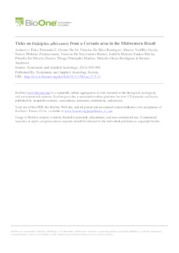Ticks on Didelphis albiventris from a Cerrado area in the Midwestern Brazil.
Ticks on Didelphis albiventris from a Cerrado area in the Midwestern Brazil.
Resumo: This experiment studied tick fauna associated to Didelphis albiventris Lund 1840 from a Cerrado area (Mato Grosso do Sul State, non-adjoining to Pantanal) inserted in a pasture and agricultural activities matrix, with few natural preserved forest patches. Authors also summarized data on ticks parasitizing Didelphis spp. in Brazil, and discussed infestation patterns in different biomes and locations. Study took place in Cervinho Farm, Bandeirantes Municipality. For captures, Tomahawk-like traps were distributed along two forest patches (30 each) during five nights. Captures occurred monthly (July/2013 to September/2014), sampling both fragments on alternate months. Animals were sedated and ticks were collected and stored in vials containing ethanol (70%) for identification. 51 D. albiventris were captured in 15 campaigns. Tick prevalence was 100%, and 49.5% of the animals were co-infested by two or more tick species. Four parasitizing species were found: Amblyomma sculptum Berlese, 1888 (78 nymphs), Ixodes loricatus Neumann, 1899 (56 adults), Amblyomma dubitatum Neumann, 1899 (45 nymphs), Amblyomma coelebs Neumann, 1899 (32 nymphs) and Amblyomma sp. (123 larvae). A. sculptum was the most abundant tick, but most frequent species were A. coelebs and A. dubitatum, followed by I. loricatus. Co-occurrences of more than two species were observed among all tick pairs. D. albiventris usually presents high prevalence of tick infestation. However, this study presented 100% prevalence. Knowledge of host-parasite relation and interactions between different ticks that coexist on a same host are essential, since such interaction may favor pathogen dissemination. This is of special relevance regarding D. albiventris, known for participating in maintenance of ecological cycles of Spotted Fever Group rickettsiae.
Ano de publicação: 2018
Tipo de publicação: Artigo de periódico
Unidade: Embrapa Gado de Corte
Observações
1 - Por padrão são exibidas publicações dos últimos 20 anos. Para encontrar publicações mais antigas, configure o filtro ano de publicação, colocando o ano a partir do qual você deseja encontrar publicações. O filtro está na coluna da esquerda na busca acima.
2 - Para ler algumas publicações da Embrapa (apenas as que estão em formato ePub), é necessário ter, no celular ou computador, um desses softwares gratuitos. Sistemas Android: Google Play Livros; IOS: iBooks; Windows e Linux: software Calibre.
Acesse outras publicações
Acesse a Base de Dados da Pesquisa Agropecuária (BDPA) para consultar o acervo completo das bibliotecas da Embrapa.

